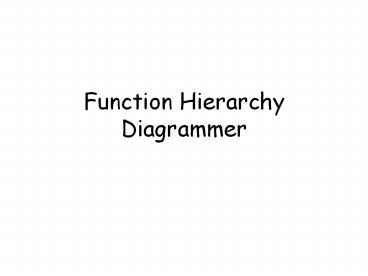Function Hierarchy Diagrammer PowerPoint PPT Presentation
Title: Function Hierarchy Diagrammer
1
Function Hierarchy Diagrammer
2
Open on Existing Function
3
From Process Model to Function Hierarchy
Base Process X
A
C
B
D
E
4
What Is a Function Hierarchy?
- Represents business processes independent
of organizational, geographical, or
political boundaries - Shows how the business fits together
- Results from functional decomposition
5
Process Models and Function Hierarchies
Where can I model . . .
The detailed steps in a function/process?
PM/FHD
The sequence of steps?
PM
What starts it off?
PM
What results from it?
PM
Where it fits with the rest of the business?
FHD
The data it uses or produces?
PM/FHD
The materials it uses or produces?
PM
Who is responsible for it?
PM/RON
6
Why use FHD instead of PM?
- Vertical View Vs. Horizontal
- Organizational Capability
- Reparenting Automation Functions
- Business Rules as Functions
- Documentation Capability
- Organizational Preference
7
Building a Function Hierarchy from Scratch
1. Identify the top-level or root function.
2. Decompose the functions.
3. Group subfunctions.
4. Remove all references to mechanisms.
5. Identify common functions.
8
How to Decompose Functions
Collect information
List candidate functions
Write a top-level function
Decompose and include functionsfrom the
candidate list
Review for completeness and relevance
Feedback to others
Decompose to elementary level and add detail
9
Elementary Business Functions
- Take the business from one state of consistency
to another or do not change the state of the
business at all - Must always continue to conclusion or be totally
undone
If an intermediate step is valid, the function is
not elementary.
10
Atomic Functions
- Defined as those on lowest level of hierarchy
- Elementary Business Functions may be atomic (most
frequent case) - Could be composed of atomic functions
11
Stop Decomposing When . . .
- The hierarchy
- Is accurate and self-contained .
- Covers the scope.
- Can be read.
- The names are succinct and meaningful.
- The functions have been sufficiently decomposed.
12
Documentation in PM
- Automation Check Box
- Timing and Cost Analysis (Main,Resources)
- Presentation (Multimedia)
- Descriptive Documentation (Text)
13
Documentation in FHD
Immediate Form Overnight Report
14
Documentation in FHD
15
Documentation in FHD
16
Documentation in FHD
17
Documentation in FHD
18
Common Functions
Terminatemembership
Managedelinquentmemberships
Requestreturn ofoverdueitems
Invalidatemembershipof delinquent customer
Identifydelinquentmembers
19
Are the Functions Really Common?
- Do the functions carry out the same processing?
- Do the functions manipulate the same information?
- Do the functions have identical decompositions?
20
Combining Common Functions
- 1. Identify common business functions.
- 2. Trace the route back up to the common parent.
- 3. Replace the common functions with a single
function.
21
Beware of Mechanisms!
Mechanism
We take the customers photograph and stick it
to the bottom left-hand side of a blank card.
Wefill in all the members details on the card.
Finally, we cover the card in plastic before
giving it to the member in person or mailing it
to the member.
Business Function
Issue new membership card
22
Indicating Candidates for Automation
- Select the To-be-automated box
- Use color
- Reparent functions into a new hierarchy
B
D
E

